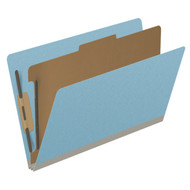The Essential Guide to Classification Folders: Types and Applications
May 30th 2024
The Essential Guide to Classification Folders: Types and Applications
When it comes to keeping documents organized, classification folders are a game-changer. Whether you're managing a small office, running a bustling business, or simply need to keep personal files in order, understanding the different kinds of classification folders and their applications can significantly enhance your productivity. In this blog, we'll explore what classification folders are, the various types available, and how you can use them effectively.
What Are Classification Folders?
Classification folders are specially designed folders that help in categorizing and separating documents within a single folder. They typically come with built-in dividers or partitions, allowing for multiple sections within one folder. This feature is incredibly useful for organizing large volumes of paperwork into manageable sections, making it easier to locate specific documents quickly.
Types of Classification Folders
Classification folders come in a variety of styles and configurations to suit different organizational needs. Here are some common types:
- 2-Section Classification Folders
- Description: These folders have a single divider, creating two sections within the folder.
- Applications: Ideal for smaller projects or for separating documents into two main categories. For example, a 2-section folder can be used to separate current and archived documents or to distinguish between two different clients.
- 4-Section Classification Folders
- Description: These folders feature two dividers, resulting in four sections.
- Applications: Perfect for more complex projects or when you need to organize documents into multiple categories. Use a 4-section folder to manage different phases of a project, such as planning, execution, review, and completion.
- 6-Section Classification Folders
- Description: These folders include three dividers, creating six sections.
- Applications: Best for comprehensive projects with multiple categories. For instance, legal professionals can use a 6-section folder to organize case files, separating client correspondence, evidence, pleadings, and more.
- Pressboard Classification Folders
- Description: Made from durable pressboard material, these folders are designed to withstand heavy use.
- Applications: Ideal for long-term storage and frequently handled documents. These are commonly used in legal, medical, and financial sectors where document integrity is paramount.
- Recycled Classification Folders
- Description: Environmentally friendly folders made from recycled materials.
- Applications: Perfect for businesses committed to sustainability. They offer the same functionality as standard classification folders while reducing environmental impact.
Applications of Classification Folders
Understanding the different types of classification folders is only part of the equation. Knowing how to use them effectively can streamline your document management process. Here are some practical applications:
- Project Management
- Use classification folders to organize documents related to different stages of a project. This ensures that all relevant information is easily accessible, improving efficiency and reducing the risk of losing critical documents.
- Client Files
- Keep client-related documents neatly categorized with classification folders. Separate sections can be dedicated to contracts, correspondence, billing, and project details, making it easier to find information when needed.
- Human Resources
- Organize employee records using classification folders. Different sections can be used for personal information, performance reviews, training records, and benefits documentation.
- Legal Documentation
- Legal professionals can benefit greatly from classification folders by keeping case files organized. Separate sections can house pleadings, evidence, correspondence, and notes, ensuring that all case materials are systematically arranged.
- Financial Records
- Use classification folders to manage financial documents such as invoices, receipts, tax records, and bank statements. This helps in maintaining a clear and organized record of all financial transactions.
Conclusion
Classification folders are an invaluable tool for anyone looking to keep their documents organized and easily accessible. By understanding the different types of classification folders and their applications, you can choose the right folder for your specific needs and enhance your document management system. Whether you’re managing a small project or handling large volumes of paperwork, there’s a classification folder that’s perfect for you.
Embrace the efficiency and order that classification folders bring to your organization, and experience the difference they can make in your daily operations.
FilingFix.com offers a wide range of classification folders to suit all your organizational needs. Visit our website to explore our collection and find the perfect solution for your document management challenges.

